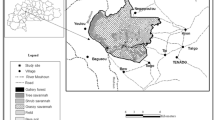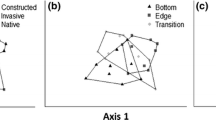Abstract
Species in temporary ponds overcome periods of unfavorable weather conditions by building up a large seed bank. With this strategy, the species diversity of ponds is preserved and information on their dynamics and structure is retained. Little is known about the characteristics, spatial patterns and role in the vegetation dynamics of the soil seed banks of Mediterranean temporary ponds, which are regarded as priority habitats under protection. We studied two sites of western Crete: Omalos, a mountain plateau at 1,060 m a.s.l. and Elafonisos, located near the coast at 60 m a.s.l. The seed bank was surveyed along transects using the germination method. Aboveground vegetation was measured on quadrats along the same transects. Canonical Correspondence Analysis (CCA) was run to define the zonation patterns. High density and species richness were recorded in both sites, with an average of 75,662 seeds/m2 found in Omalos and 22,941 seeds/m2 in Elafonisos. The community composition of both sites was remarkably different but in both locations perennial species were inconspicuous while annuals, prevailed in the seed banks. An important array of protected or rare species as well as several others which were absent from the vegetation were hosted in the soil seed banks, thereby rendering a low similarity between their composition. Soil seed banks in these ecosystems indicated a spatial heterogeneity that mirrored the aboveground vegetation distribution, sorted along the moisture gradient by their tolerance to flooding. Soil seed banks play a key role in the vegetation recovery after summer drought. The acts of preserving the soil seed bank and ensuring a transient flooding regime are essential to protect the unique vegetation communities of Mediterranean temporary ponds.



Similar content being viewed by others
References
Amiaud B, Touzard B (2004) The relationships between soil seed bank aboveground vegetation and disturbances in old embanked marshlands of Western France. Flora 199:25–35
Aponte (2007) The soil seed bank of Mediterranean temporary ponds in western Crete. MSc Thesis, Mediterranean Agronomic Institute of Chania, Greece
Bauder E (2000) Inundation effect on small-scale plant distributions in San Diego, California vernal pools. Aquat Ecol 34:43–61
Bauder E (2005) The effects of an unpredictable precipitation regime on vernal pool hydrology. Freshw Biol 50:2129–2135
Beja P, Alcazar R (2003) Conservation of Mediterranean temporary ponds under agricultural intensification, an evaluation using amphibians. Biol Conserv 114:317–326
Benoit D, Kennel N, Cavers P (1989) Factors influencing the precision of soil seed bank estimates. Can J Bot 67:2833–2839
Benvenuti S (2003) Soil texture involvement in germination and emergence of buried weed seeds. Agron J 95:191–198
Bergmeier E (2005) Short report on the environment, flora and vegetation of the “Omalos Pond”. University of Göttingen, Germany. LIFE Nature 2004 “Actions for the Conservation of the Mediterranean Temporary Ponds in Crete”
Bliss S, Zedler P (1997) The germination process in vernal pools, sensitivity to environmental conditions and effects on community structure. Oecologia 113:67–73
Brock MA, Rogers KH (1998) The regeneration potential of the seed bank of an ephemeral floodplain in South Africa. Aquat Bot 61:123–135
Capon SJ, Brock MA (2006) Flooding, soil seed bank dynamics and vegetation resilience of a hydrologically variable desert floodplain. Freshw Biol 51:206–223
Casanova M, Brock M (2000) How do depth, duration and frequency of flooding influence the establishment of wetland plant communities. Plant Ecol 147:237–250
Council Directive 92/43/EEC (1992) 21 May 1992 on the conservation of natural habitats and of wild fauna and flora. Official Journal L 206, 22/07/1992 P. 0007–0050
Crowe EA, Busacca AJ, Reganold JP, Zamora BA (1994) Vegetation zones and soil characteristics in vernal pools in the Channeled Scabland of eastern Washington. Great Basin Nat 54:234–247
Dimitriou E, Karaouzas I, Skoulikidis N, Zacharias I (2006) Assesing the environmental status of Mediterranean temporary ponds in Greece. Ann Limnol-Int J Lim 42:33–41
Egan TP, Ungar IA (2000) Similarity between seed banks and above-ground vegetation along a salinity gradient. J Veg Sci 11:189–194
Fernandez-Alaez C, Fernandez-Alaez M, Becares E (1999) Influence of water level fluctuation on the structure and composition of the macrophyte vegetation in two small temporary lakes in the northwest of Spain. Hydrobiologia 415:155–162
Forcella F (1984) A species-area curve for buried viable seeds. Aust J Agric Res 35:645–652
Grillas P, Garcia-Murillo P, Geertz-Hansen O, Marba N, Montes C, Duarte CM, Tan Ham L, Grossmann A (1993) Submerged macrophyte seed bank in a Mediterranean temporary marsh, abundance and relationship with established vegetation. Oecologia 94:1–6
Grillas P, Gauthier P, Yavercovski N, Perennou C (eds) (2004) Mediterranean temporary pools; vol 1, Issues relating to conservation, functioning and management. Station biologique de la Tour du Valat, France
Gross K (1990) A comparison of methods for estimating seed numbers in the soil. J Eclo 78:1079–1093
Harper J (1977) Population biology of plants. Academic Press, New York
Huston M (1994) Biological diversity: the coexistence of species on changing landscapes. Cambridge University Press, Cambridge
Jahn R, Schönfelder P (1995) Exkussionflora für Kreta. Ed. Ulmer. Germany
James CS, Capon SJ, White MG, Rayburg SC, Thoms MC (2007) Spatial variability of the soil seed bank in a heterogeneous ephemeral wetland system in semi-arid Australia. Plant Ecol 19:205–217
Kent M, Coker P (1992) Vegetation descriptions and analysis, a practical approach. Belhaven Press, London
Leck M (1989) Wetland seed banks. In: Leck M, Parker V, Simpson R (eds) Ecology of soil seed banks, chap 13. Academic Press, California
Leck M, Parker V, Simpson R (1989) Seed banks, general concepts and methodological issues. In: Leck M, Parker V, Simpson R (eds) Ecology of soil seed banks, chap 1. Academic Press, California
Marañón T (1998) Soil seed bank and community dynamics in an annual dominated Mediterranean salt-marsh. J Veg Sci 9:371–378
McCarthy K (1987) Spatial and temporal distribution of species in two intermittent ponds in Atlantic County, New Jersey. MSc Thesis. Rutgers Uiversity
Rhazi L, Grillas P, Tan Ham L, El Khyari D (2001a) The seed bank and the between years dynamics of the vegetation of a Mediterranean temporary pool (NW Morocco). Ecol Mediterr 27:68–88
Rhazi L, Grillas P, Toure AM, Tan Ham L (2001b) Impact of land use in catchment and human activities on water, sediment and vegetation of Mediterranean temporary pools. C R Acad Sci III Sci Vie 324:165–177
Roberts H (1981) Seed banks in soil. Adv Appl Biol 6:1–55
Schwartz S, Jenkins D (2000) Temporary aquatic habitats: constraints and opportunities. Aquat Ecol 34:3–8
Seabloom E, Van der Valk A, Molones K (1998) The role of water depth and soil temperatures in determining initial composition of prairie wetland coenoclines. Plant Ecol 138:203–216
Serrano L, Serrano L (1995) Influences of groundwater exploitation for urban water supply on temporary ponds. J North Am Benthol Soc 15:64–68
Smith LM, Kadlec JA (1983) Seed banks and their role during drawdown of a North American Marsh. J Appl Ecol 20:673–684
Sørensen T (1948) A method of establishing groups of equal amplitude in plant sociology based on similarity of species content, and its application to analysis of the vegetation on Danish commons. Kongelige Danske Videnskabernes Selskabs Biologiske Skrifter 5:1–34
Ter Braak CJF (1986) Canonical correspondence analysis, a new eigenvector technique for multivariate direct gradient analysis. Ecology 67:1167–1179
Ter Braak CJF (1987) The analysis of vegetation-environment relationships by canonical correspondence analysis. Vegetatio 69:69–77
Ter Braak CJF, Smilauer P (2002) Canoco for windows version 4.53. Biometris-Plant research Internationals, Wageningen
The Ramsar Convention of Wetlands (1971) (Ramsar, Iran 1971) Resolution VIII. 33, Guidance for identifying, sustainably managing, and designating temporary pools as Wetlands of International Importance. 8th Meeting of the Conference of the Contracting Parties to the Convention on Wetlands, “Wetlands, water, life, and culture” Valencia, Spain, 18–26 Nov 2002
Thompson K (1992) The functional ecology of seed banks. In: Fenner M (ed) Seeds: the ecology of regeneration in plant communities. CAB International, Wallingford, pp 231–258
Thompson K, Grime J (1979) Seasonal variation in the seed banks of herbaceous species in ten contrasting habitats. J Ecol 67:893–921
Turland NJ, Chilton L, Press JR (1993) Flora of the cretan area, Annotated checklist & atlas. Ed. The Natural History Museum, London
Ungar IA (2001) Seed banks and seed population dynamics of halophytes. Wetlands Ecol Manage 9:499–510
Van der Valk A, Davis C (1976) The seed banks of prairie glacial marshes. Can J Bot 54:1832–1838
Van der Valk A, Davis C (1978) The role of seed banks in the vegetation dynamics of prairie glacial marshes. Ecology 59:322–335
Van der Valk A, Weeling C (1988) The development of zonation in freshwater wetlands. Paper 38 of the Marsh ecology research project. Delta waterfowl and wetlands research Station, Delta
Warwick NWM, Brock MA (2003) Plant reproduction in temporary wetlands, the effects of seasonal timing, depth, and duration of flooding. Aquat Bot 77:153–167
Zedler P (1987) The ecology of Southern California vernal pools, a community profile. US Fish and Wildlife Service. Biological Report 85 (7.11) May
Acknowledgments
The work presented in this paper was carried out in the framework of the LIFE-Nature project entitled “Actions for the Conservation of the Mediterranean Temporary Ponds in Crete” (LIFE04 NAT/GR/000105) and a scholarship granted to the first author by the Mediterranean Agronomic Institute of Chania, Greece (MAICh-CIHEAM). Special thanks are expressed to Nikos Papadonakis for his advices on green house work. Thanks are also extended to the fellow researchers of the Herbarium at MAICh. Dr. Patrick Grillas and Dr. Erwin Bergmeier are thanked for their suggestions and fruitful interaction throughout this research.
Author information
Authors and Affiliations
Corresponding author
Rights and permissions
About this article
Cite this article
Aponte, C., Kazakis, G., Ghosn, D. et al. Characteristics of the soil seed bank in Mediterranean temporary ponds and its role in ecosystem dynamics. Wetlands Ecol Manage 18, 243–253 (2010). https://doi.org/10.1007/s11273-009-9163-5
Received:
Accepted:
Published:
Issue Date:
DOI: https://doi.org/10.1007/s11273-009-9163-5




